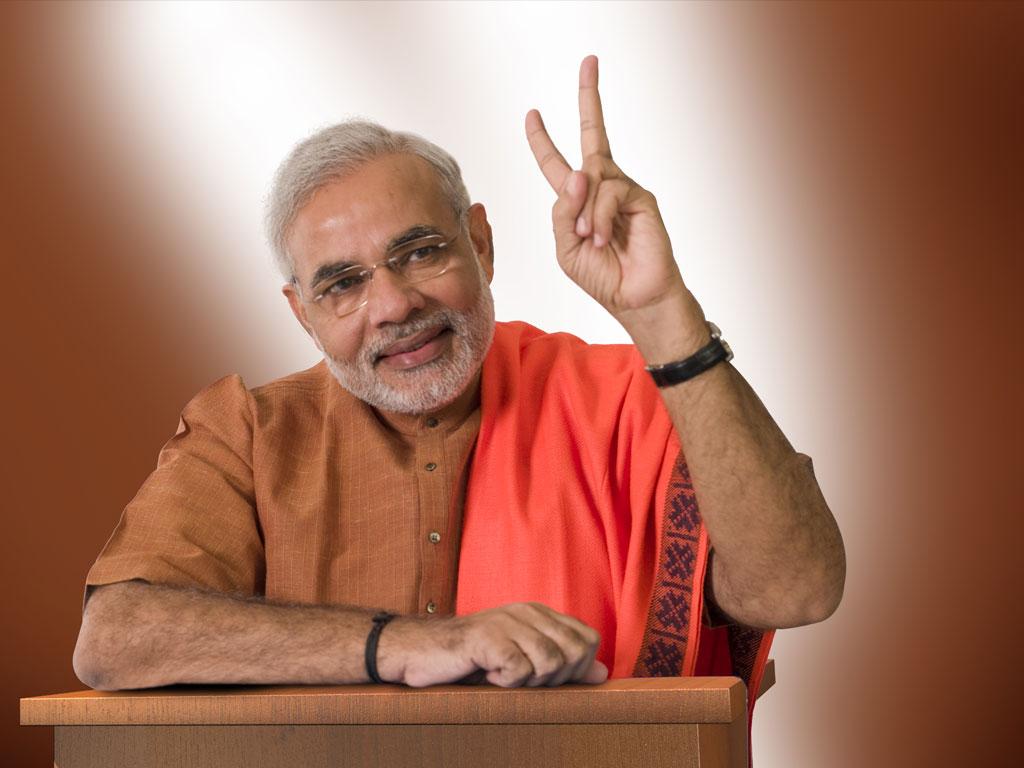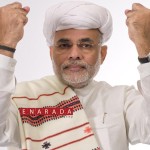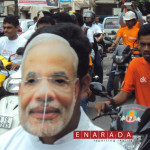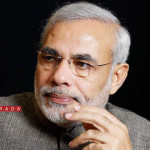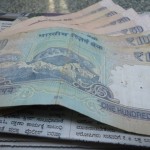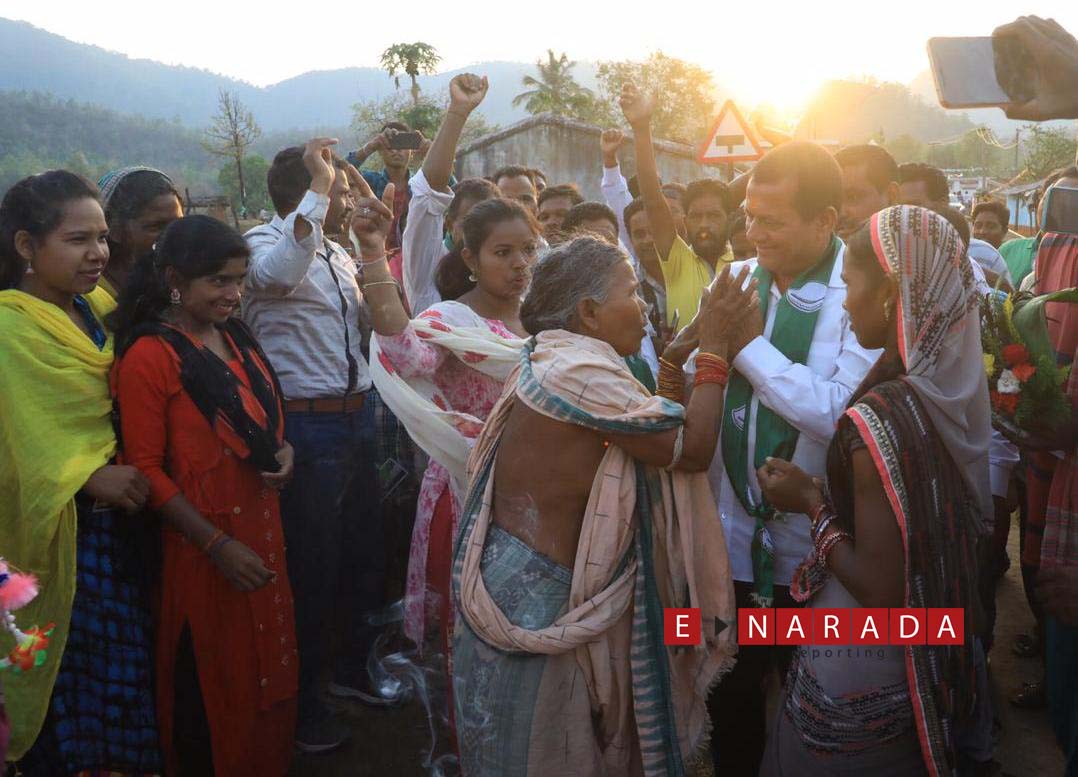ENARADA, NEW DELHI
By AJAY N JHA
“You can love me, you can hate me but you cannot ignore me” Gujarat Chief Minister and BJP’s Pm candidate Narendra Modi is literally living up to this epithet and actually relishing it. Every political rival has been taking a pot-shot at him at the drop of a hat and yet Modi continues to emerge stronger and has been thumping across the country as BJP’s brightest star. Even Congress party’s poll managers have now started admitting in private that Modi juggernaut is virtually unstoppable now. !!
A closer and critical look as Modi’s phenomenal rise in stature and popularity across the country reveals the following points.
1. He has been scoring at free-will and hitting his rivals the hardest in every political rally across the country even as other political parties have made it a battle between Modi’s 12 years rule in Gujarat vs 10 years of UPA rule at the centre.
2. The people’s frustration against the UPA government at the centre which was marked by a plethora of scams and scandals, sky-rocketing price rise of essential commodities, the monthly whammy in increased rate of petrol and diesel have turned them away from the Congress and their collective anger and anguish was reflected the last assembly polls where the Congress party’s tally reached all-time low.
3. Apart from his fire-brand speech, choice of right worlds to lampoon and lambast the Congress leaders and his extremely smart and innovative media campaign, Modi has slowly and steadily emerged as the darling of middle Class as well as the young voters who still like Hero worship. His popularity among the youth has been a revelation and if the rating on social media sites are an indication, then he has already sprinted miles ahead of his political rivals.
4. Indian Parliamentary polls have always seen a sizeable amount of floating voters undecided till the last moment. But various poll surveys have clearly indicated that even the majority of those “floating voters” appear to have made up their mind to vote for Modi.
5. It is not that the 10 years of UPA rule was bad. In fact, this dispensation came out with many historical decisions including Right to Information, Food Security Bill, Right to Education, Land acquisition Bill, NAREGA, MANREGA, Lokpal Bill and a slew of other equally important measures. But it could just not market them. Modi on the other hand, kept carefully choosing his targets and the issues and has been executing the assault to near perfection. He always chose the Gandhi’s and Prime Minister Manmohan Singh as his targets and kept raking up inflation and corruption and the government’s inability to curb price rise and rising unemployment, declining growth rate and used the “choicest of idioms and phrases” with deadly impact.
6. The index of his popularity could be seen in the fact that not only many regional outfits and satraps have been making a beeline into BJP headquarters, even a section of Muslim community appears to have started realizing that there was no harm in giving him a chance as the country’s next Prime Minister. Their yardstick for support for Modi is that’ at least there were no communal conflagration in Gujarat during last 1o years while Muslims were hounded and butchered in Maulana Mulayam’s Sultanate”
In the light of the above, Modi’s decision to contest from the historic Varanasi parliamentary seat seems to be a well calculated and calibrated move which would not only have a catapulting impact across the eastern region of the country but its reverberations would be felt right up to the shores of Rameshwaram.
Apart from other things, Varanasi also symbolizes the Hindu pride and Modi contesting from this place would have a huge advantage for the party not only in Uttar Pradesh which has 80 parliamentary seats but also up to Bihar which has 40 seats. Obviously, BJP’s target is to get at least 60 out of the total of 120 seats. Samajwadi party was the wall which sopped the BJP surge in UP in both 2004 and 2009 and this time around, Modi is determined to make a huge dent into the Mulayam Singh’s backyard. That is why he sent his close confidant Amit Shah to take control of this area.
Secondly, it would also influence the Muslim voters in both these States. The biggest dilemma for UPA’s Muslims has been how to consolidate their vote against Modi. But here also, some cracks have already started appearing. The chances are that the majority of Muslims would tactically vote for BSP as they are clearly annoyed with Samajwadi in the wake of Muzaffarnagar riots. Even if the Congress and BSP join hands, Muslim voters would be more confused in trying to figure out how not to split their vote.The induction of AAP in Uttar Pradesh cauldron would complicate things further and at the end, a confused Muslim voting pattern would indirectly help BJP.
Thirdly, Modi’s presence in Varanasi would also have a huge impact in 10 Parliamentary constituency in Bihar which are bordering UP. With both Udit Raj and LJP leader Ram Vilas having joined the BJP wand wagon, the chances of BJP getting at least 25 to 28 seats out of the total of 40 becomes brighter.
Above all, this round of Lok Sabha polls is going to be all about corruption and good governance. Despite Modi’s alleged pandering to crony capitalists, his track record as administrator remains far superior to that of Arvind kejriwal even if he tries to challenge Modi in Varanasi. Kejriwal has been seen as a hit-and run leader and more as an anarchist which no sane person of this country would prefer.
The other side of the spectrum for the BJP has been equally interesting which most political pundits and commentators have not been able to observe and analyze in detail. That is because many of these analysts and commentators have seen the area only with the prism of their “blinkered perceptions” or carefully avoided it for the fear of being branded either as BJP supporter or the Congress cohort.
To a neutral observer, it is equally apparent that along with Modi’s canonization as the “Lion of Gujarat”, there is also a very clever and concerted attempt to camouflage other considerations that go into the making of a strong party base in caste dominated area like Uttar Pradesh.
The fact remains that the caste plays an important role in elections and even the BJP which always tom tommed itself as a party with difference, has ultimately fallen back on the same matrix. While the BJP has been gaining ground in political discourse and public perception mainly because of Modi’s rabble-rousing oratorical style, the Old guards as well as RSS functionaries have been quietly connecting the dots in caste matrix in a traditional manner. The BJP leaders have not only been contacting leaders of all castes they have been associated with, they have also extended their reach to Dalits, backwards and Maha Dalits.
While both Congress and SP have been raising the issue of reservation for members of such castes or socio- political representation to them, the BJP has been enticing them to come into its fold with the promise of greater importance. The BJP has been traditionally known as party of Bramhins and Banias with a stronghold in northern belts and particularly in the Cow belt areas. But with the emergence of powerful OBC (Lodh) leader like Kalyan Singh kalvi in 1990s, it realized that it had to involve larger section of Hindus in order to emerge as a major political force.
No wonder then what while both Congress and SP leaders have been attacking BJP for its communal antecedents, a few senior BJP leaders were engaged in “caste engineering” and setting up new equations. The emergence of other OBC leaders like Vinay katiyar, Uma Bharti and a few others amplify this. The selection of Amit Shah to head BJP’s “Mission 2014 “in Uttar Pradesh was not only because of his excellent managerial and persuasion skills but also for the ease and efficacy with which he communicates with the OBCs.
Amit Shah has been quietly nurturing Kurmis and Patels in UP who remain neglected as compared to Yadavs. That is how not only the OBCs but even the most backward Classes(MBCs) like Kumhars(potters), Bunkars(weavers) Nau(barbers) Badhai(carpenters), Sunar( goldsmith) and Teli( oil grinders) have been getting drawn to BJP.
The BJP think-tank is putting a lot of effort and strategic thinking in expanding the reach of the party to those corners of Hindu society that other parties do not consider to be a significant vote bank. Drawing in Dr Udit Raj and LJP leader Ram Vilas paswan has been a part of this strategy. Dr Udit Raj’s Indian justice party is said to have an influence over that section of Dalits which is apathetic to Mayawati and more into business and academics
The saffron brigade has carefully crafted the identity of Modi as a tea-seller as a huge draw and the Chay pe charcha has been received in s positive away during the last 20 days across various regions.
On the other hand, Bramhin stalwarts like Murli manohar Joshi, Kalraj Mishra and kesrinath tripathi have managed to retain the allegiance of a section of their caste voters with the BJP whereas another section has moved away to Bahujan Samaj party because of the efforts of BSP leader Satish Chandra Mishra.
As for Kshatriyas, the UP BJP leadership was led by SP Sahi before the present incumbent Laxmikant Vajpayee took over. Yogi Adityanath of Gorakhpur is another strong Kshatriya leader who wields considerable influence in the community in Eastern Uttar Pradesh. The BJP had also opened a dialogue with Raghuraj Pratap Singh alias Raja Bhaiya before he was inducted into Akhilesh yadav Ministry.
Thus with almost all levels of Hindu castes having been contacted, covered and included into its poll strategy, the BJP is expecting a bumper harvest in its Mission 2014 and Narendra Modi himself contesting from Varanasi is going to be the icing on the cake.
As of now, BSP is the only party who could challenge Modi’s march towards 7 race course as its caste voters are more or less intact. The image of Akhilesh Yadav government has taken a tremendous beating in last few months and it may find difficult to retain 14 to 16 Lok Sabha seats. The Congress party, on the other hand, already appears to have been thrown into the throes of crisis and even the local intelligence reports say that most of the sitting Ministers are likely to lose elections.
Under these circumstances, Modi’s dream of getting at least 35 to 45 seats from Uttar Pradesh alone would not be far from reality because the overall mood in the country is for a change and if the people’s mood for a decisive verdict in State Assembly elections since 2010 is any indication, it can be safely said that the BJP would emerge as the party with maximum number of seats in its kitty.
(Posted on March 11, 2014 @ 1:30pm)
(Ajay N Jha is a veteran journalist from both Print and Electronic media. He is Advisor to Prasar Bharti. The views expressed are his personal. His email id is Ajay N Jha <ajayjha30@gmail.com> )
The views expressed on the website are those of the Columnists/ Authors/Journalists / Correspondents and do not necessarily reflect the views of ENARADA.

